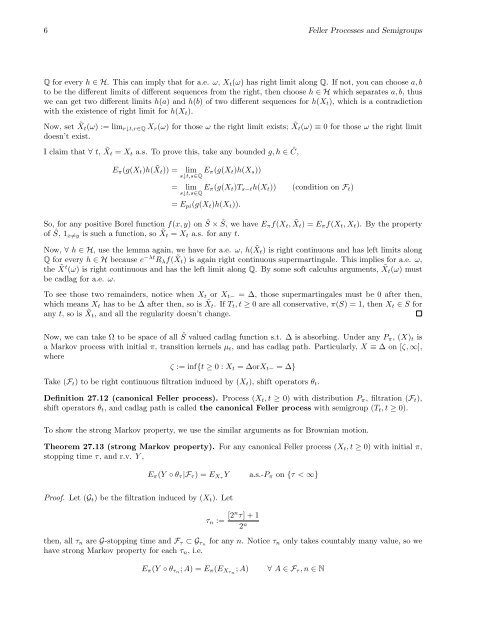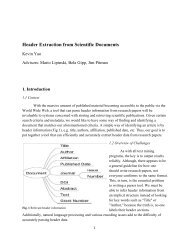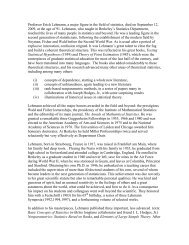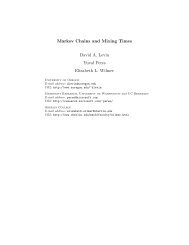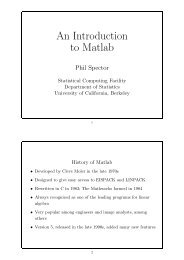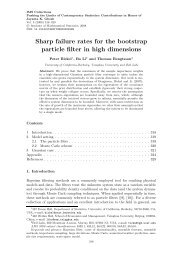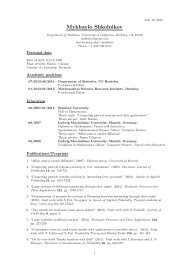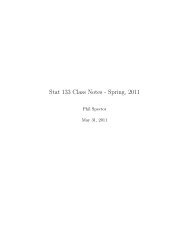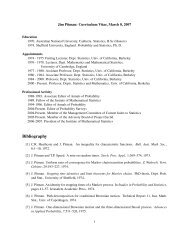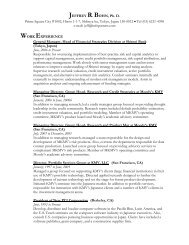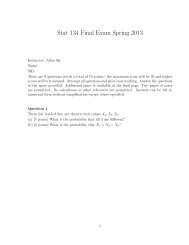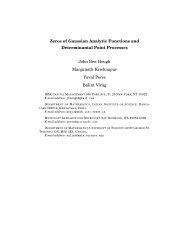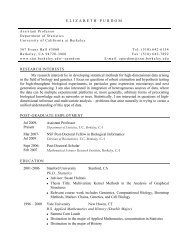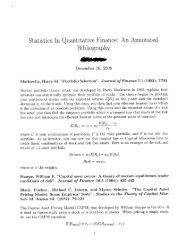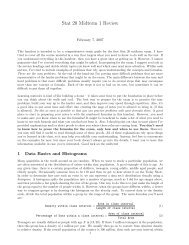Feller Processes and Semigroups
Feller Processes and Semigroups
Feller Processes and Semigroups
You also want an ePaper? Increase the reach of your titles
YUMPU automatically turns print PDFs into web optimized ePapers that Google loves.
6 <strong>Feller</strong> <strong>Processes</strong> <strong>and</strong> <strong>Semigroups</strong><br />
Q for every h ∈ H. This can imply that for a.e. ω, X t (ω) has right limit along Q. If not, you can choose a, b<br />
to be the different limits of different sequences from the right, then choose h ∈ H which separates a, b, thus<br />
we can get two different limits h(a) <strong>and</strong> h(b) of two different sequences for h(X t ), which is a contradiction<br />
with the existence of right limit for h(X t ).<br />
Now, set ˜X t (ω) := lim r↓t,r∈Q X r (ω) for those ω the right limit exists; ˜Xt (ω) ≡ 0 for those ω the right limit<br />
doesn’t exist.<br />
I claim that ∀ t, ˜Xt = X t a.s. To prove this, take any bounded g, h ∈ Ĉ,<br />
E π (g(X t )h( ˜X t )) =<br />
lim E π(g(X t )h(X s ))<br />
s↓t,s∈Q<br />
= lim<br />
s↓t,s∈Q E π(g(X t )T s−t h(X t )) (condition on F t )<br />
= E pi (g(X t )h(X t )).<br />
So, for any positive Borel function f(x, y) on Ŝ × Ŝ, we have E πf(X t , ˜X t ) = E π f(X t , X t ). By the property<br />
of Ŝ, 1 x≠y is such a function, so ˜X t = X t a.s. for any t.<br />
Now, ∀ h ∈ H, use the lemma again, we have for a.e. ω, h( ˜X t ) is right continuous <strong>and</strong> has left limits along<br />
Q for every h ∈ H because e −λt R λ f( ˜X t ) is again right continuous supermartingale. This implies for a.e. ω,<br />
the ˜X t (ω) is right continuous <strong>and</strong> has the left limit along Q. By some soft calculus arguments, ˜Xt (ω) must<br />
be cadlag for a.e. ω.<br />
To see those two remainders, notice when X t or X t− = ∆, those supermartingales must be 0 after then,<br />
which means X t has to be ∆ after then, so is ˜X t . If T t , t ≥ 0 are all conservative, π(S) = 1, then X t ∈ S for<br />
any t, so is ˜X t , <strong>and</strong> all the regularity doesn’t change.<br />
Now, we can take Ω to be space of all Ŝ valued cadlag function s.t. ∆ is absorbing. Under any P π, (X) t is<br />
a Markov process with initial π, transition kernels µ t , <strong>and</strong> has cadlag path. Particularly, X ≡ ∆ on [ζ, ∞],<br />
where<br />
ζ := inf{t ≥ 0 : X t = ∆orX t− = ∆}<br />
Take (F t ) to be right continuous filtration induced by (X t ), shift operators θ t .<br />
Definition 27.12 (canonical <strong>Feller</strong> process). Process (X t , t ≥ 0) with distribution P π , filtration (F t ),<br />
shift operators θ t , <strong>and</strong> cadlag path is called the canonical <strong>Feller</strong> process with semigroup (T t , t ≥ 0).<br />
To show the strong Markov property, we use the similar arguments as for Brownian motion.<br />
Theorem 27.13 (strong Markov property). For any canonical <strong>Feller</strong> process (X t , t ≥ 0) with initial π,<br />
stopping time τ, <strong>and</strong> r.v. Y ,<br />
E π (Y ◦ θ τ |F τ ) = E Xτ Y a.s.-P π on {τ < ∞}<br />
Proof. Let (G t ) be the filtration induced by (X t ). Let<br />
τ n := [2n τ] + 1<br />
2 n<br />
then, all τ n are G-stopping time <strong>and</strong> F τ ⊂ G τn<br />
have strong Markov property for each τ n , i.e.<br />
for any n. Notice τ n only takes countably many value, so we<br />
E π (Y ◦ θ τn ; A) = E π (E Xτn ; A)<br />
∀ A ∈ F τ , n ∈ N


